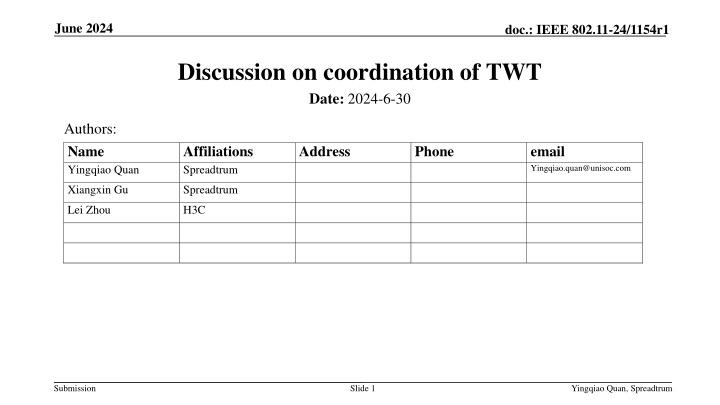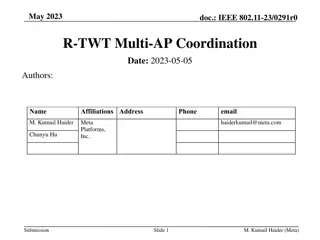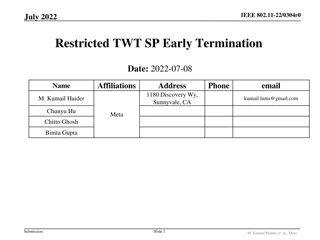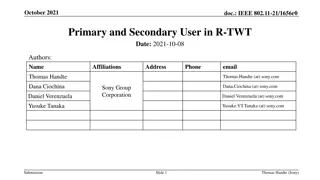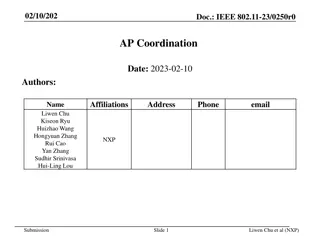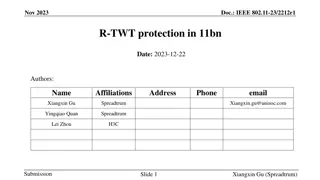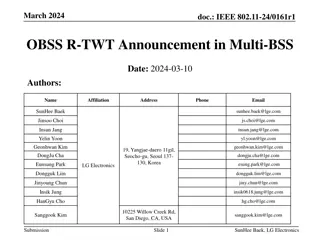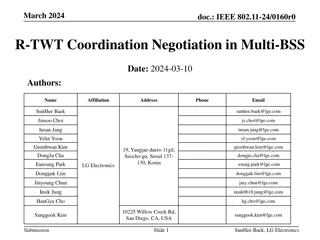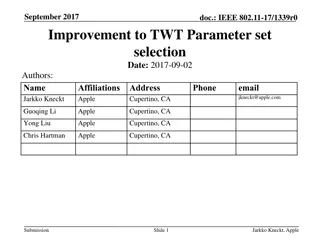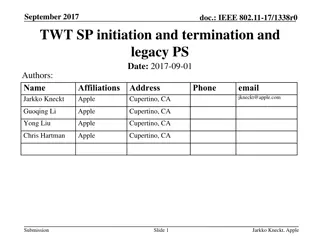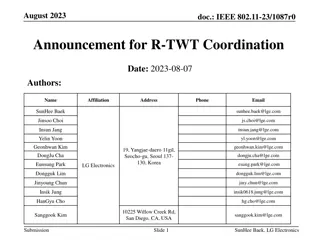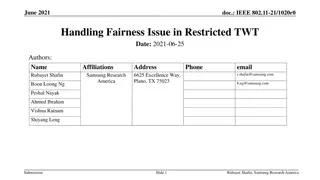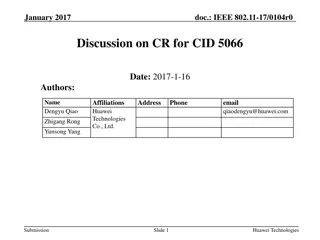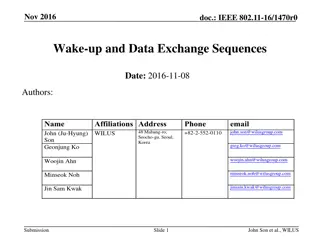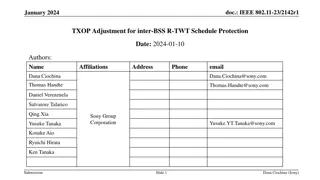Multi-AP Coordination for Target Wake Time (TWT)
This document discusses the coordination of Target Wake Time (TWT) among multiple Access Points (APs) in IEEE 802.11 networks. It explores the benefits of TWT in minimizing contention, enhancing efficiency, and managing channel access. Examples of TWT coordination schemes are presented, focusing on improving Service Period (SP) protection and overall network performance.
Download Presentation

Please find below an Image/Link to download the presentation.
The content on the website is provided AS IS for your information and personal use only. It may not be sold, licensed, or shared on other websites without obtaining consent from the author.If you encounter any issues during the download, it is possible that the publisher has removed the file from their server.
You are allowed to download the files provided on this website for personal or commercial use, subject to the condition that they are used lawfully. All files are the property of their respective owners.
The content on the website is provided AS IS for your information and personal use only. It may not be sold, licensed, or shared on other websites without obtaining consent from the author.
E N D
Presentation Transcript
June 2024 doc.: IEEE 802.11-24/1154r1 Discussion on coordination of TWT Date: 2024-6-30 Authors: Name Yingqiao Quan Affiliations Spreadtrum Address Phone email Yingqiao.quan@unisoc.com Xiangxin Gu Spreadtrum Lei Zhou H3C Submission Slide 1 Yingqiao Quan, Spreadtrum
June 2024 doc.: IEEE 802.11-24/1154r1 Introduction R-TWT is a mechanism for LLT to get transmitted first. Multi-AP coordination is useful for better R-TWT SP protection. In this presentation, we focus on multi-AP coordination for TWT, not just R-TWT. Submission Slide 2 Yingqiao Quan, Spreadtrum
June 2024 doc.: IEEE 802.11-24/1154r1 Background Target wake time (TWT) is a mechanism by which a specific time or set of Service Periods (SPs) is negotiated between two individual STAs or broadcasted by an AP to multiple non- AP STAs. STAs are expected to be awake for data transmission during the Service Periods. TWT allows STAs to manage activity in the BSS by scheduling STAs to operate at different times in order to minimize contention and to reduce the required amount of time that a STA utilizing a power management mode needs to be awake. TWT had been introduced in 802.11ah and was extended by subsequent amendments. Broadcast TWT in 802.11ax; Restricted TWT in 802.11be. In UHR SG and TGbn, there are many contributions discussed enhancements and usage extension of TWT mechanism: AP power save : [23/2040], [24/0097]; P2P & co-ex : [24/0509], [24/0436], [23/2002], [23/1424]; Relay : [24/0819]; NPCA : [24/0538]. Submission Slide 3 Yingqiao Quan, Spreadtrum
June 2024 doc.: IEEE 802.11-24/1154r1 Discussion Currently, we only focus on the multiple APs coordination schemes on R-TWT SPs for further protection of LLT delivery. Besides R-TWT, we think that MAP coordination can be used for TWT for better manageability. Achieve more probability to access the channel; Avoid the congestion and mitigate collision; Increase the efficiency of WM. For showing possible cases of TWT coordination, several examples are listed in the following slides. These examples are just sketches of the TWT coordination for concept description. The detail of different usages and coordination schemes of TWT could be discussed further. Note: The TWT agreements mentioned here are based on b-TWT, but might be extend to i-TWT. Submission Slide 4 Yingqiao Quan, Spreadtrum
June 2024 doc.: IEEE 802.11-24/1154r1 Example 1 AP1 has set up a NPCA TWT (TWT 1) membership with some of its associated STAs. Within the NPCA TWT, if P20 is busy, AP1 and some of its associated STAs will try to switch to NPCA PCH to access the WM. Base on [24/0538], It is anticipated that there would be heavy traffic during the TWT SPs and OBSSs with staggered parking channels reduce collisions AP2 will setup a 11ax b-TWT agreement for STA s PS and reducing contention. If there is no other TWT SP overlapping with TWT 1 SPs at the view of AP2, AP 2 could setup TWT 2 SPs overlapped with TWT 1 SPs. AP 1 will/might switch to NPCA PCH during TWT 1 SP because of some transmission by hidden nodes to AP2, and the probability for AP 2 to access to P20 might be higher. The operating channel BW of AP 2 is overlapped with the P20 channel of AP1. TWT 1 SP AP 1 NPCA Primary Channel Primary Channel STA1 NPCA Primary Channel Primary Channel TWT 2 SP AP2 STA2 STA 2 unavailable DATA ACK/BA Submission Slide 5 Yingqiao Quan, Spreadtrum
June 2024 doc.: IEEE 802.11-24/1154r1 Example 2 AP1 has setup a AP power save TWT (TWT 1) with its associated STAs. Within TWT 1, AP1 will be in power saving mode. AP1 might be unavailable in TWT 1 SP. Simplicity and predictability from a protocol perspective [23/2040] AP2 will setup a 11ax b-TWT agreement for STA s PS and reducing contention. If there is no other TWT SP overlapping with TWT 1 SPs at the view of AP2, it is better for AP 2 to setup TWT 2 SP overlapped with TWT 1. AP 1 will be unavailable, it will not occupy the WM or cause interference to the WM. TWT 1 SP AP 1 AP1 unavailable STA1 TWT 2 SP AP2 STA2 STA 2 unavailable DATA ACK/BA Submission Slide 6 Yingqiao Quan, Spreadtrum
June 2024 doc.: IEEE 802.11-24/1154r1 Example 3 AP1 has setup a Co-ex TWT (TWT 1) with some of its associated STAs. Within TWT 1 during which these STAs may suffer from co-ex event and be temporarily unavailable or with limit capabilities for frame exchange. AP2 will setup a 11ax b-TWT agreement for STA s PS and reducing contention. If there is no other TWT SP overlapping with TWT 1 SPs at the view of AP2, it may be better for AP 2 to setup TWT 2 SP overlapped with TWT 1. Some of STAs in BSS1 may suffer co-ex event and some restriction might affect the channel access which will be disadvantageous to the efficiency and reliability. TWT 1 SP AP 1 STA1 Co-ex event TWT 2 SP AP2 STA2 STA 2 unavailable DATA ACK/BA Submission Slide 7 Yingqiao Quan, Spreadtrum
June 2024 doc.: IEEE 802.11-24/1154r1 Example 4 AP1 has setup an R-TWT (TWT 1) with some of its associated STAs. Within TWT 1, there might be some LLT transmission. AP2 will setup a 11ax b-TWT agreement for STA s PS and reducing contention. It is better for AP 2 to setup TWT 2 SP not overlapped with TWT 1. TWT 1 SP AP 1 STA1 TWT 2 SP AP2 STA2 STA 2 unavailable DATA ACK/BA Submission Slide 8 Yingqiao Quan, Spreadtrum
June 2024 doc.: IEEE 802.11-24/1154r1 Example 5 There are LLT in BSS1 and BSS2 and these LLT have same priority and similar pattern. It is unacceptable for each of AP to avoid the overlapping and delaying its R-TWT SP. AP1 and AP2 could setup 2 overlapped R- TWT and use MAPC transmission schemes to satisfy the requirement of LLT for each other. E.g. C-TDMA could be used in this example. TWT 1 SP AP 1 STA1 TWT 2 SP AP2 STA2 MU-RTS TXS DATA ACK/BA CTS Submission Slide 9 Yingqiao Quan, Spreadtrum
June 2024 doc.: IEEE 802.11-24/1154r1 Example 6 STA1 is associated with AP1 and STA2 is associated with AP2. There are P2P traffic between STA1 and STA2. AP1 and AP2 could setup an OBSS P2P TWT which is constituted by TWT 1 of BSS1 and TWT 2 of BSS2 . STA1 and STA2 will wakeup in TWT 1 SP and TWT 2 SP which are overlapped and do P2P transmission. TWT 1 SP AP 1 STA1 STA 1 unavailable TWT 2 SP AP2 STA2 STA 2 unavailable DATA ACK/BA Submission Slide 10 Yingqiao Quan, Spreadtrum
June 2024 doc.: IEEE 802.11-24/1154r1 Conclusion TWT has good scalability and portability. It is possible for TWT to be extended in 11bn. To achieve more efficiency and reliability, coordination on TWT agreements with different usages should be considered. The details of different usages and coordination schemes of TWT need to be discussed further. Submission Slide 11 Yingqiao Quan, Spreadtrum
June 2024 doc.: IEEE 802.11-24/1154r1 References [23/2040] Enabling AP power save_follow up [24/0097] AP Power Management - Follow up; [24/0509] Thoughts on in-device coexistence and P2P for 11bn [24/0436] SP-based-in-device-coexistence [23/2002] In-device coexistence and interference follow-up [23/1424] Follow-up on peer-to-peer (P2P) communication for UHR [24/0819] TWT for relay [24/0538] SP-based non-primary channel access Submission Slide 12 Yingqiao Quan, Spreadtrum
